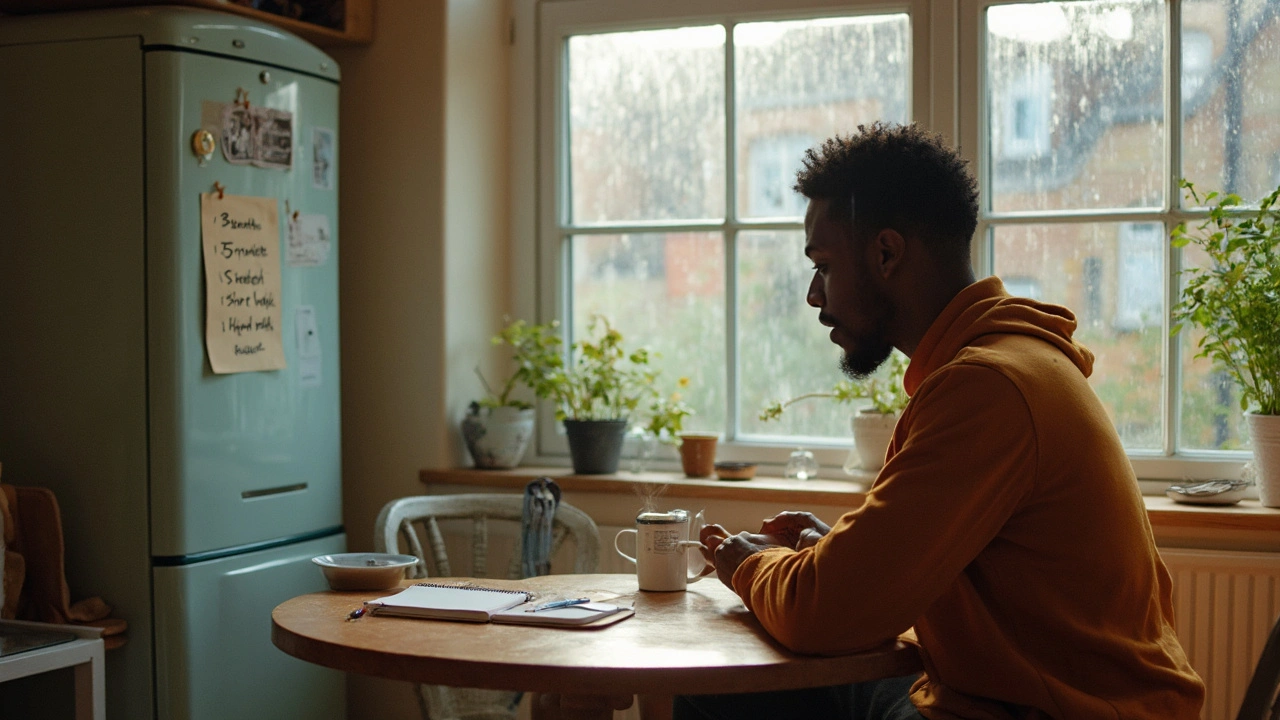You want a calmer mind, not a five-hour routine you’ll quit by Friday. Stress won’t vanish-life in 2025 is loud and crowded-but you can shrink the spikes, steady your mood, and get your head back when it runs off. Here’s a clear, evidence-backed way to do it without turning your day inside out.
What you’ll get here: quick techniques that actually lower your body’s stress response, a simple daily plan you can fit around work and family, and a way to tell if it’s working. No fluff. Just the tools that move the needle.
TL;DR:
- Calm now: Use a 90‑second “physiological sigh” or 5 minutes of slow breathing (about 6 breaths/minute) to drop heart rate and tension fast.
- Build your base: Protect sleep, move your body 20-30 minutes most days, and cap caffeine by midday. Small wins, repeated, beat dramatic resets.
- Manage triggers: Audit your stress “peaks” for one day. Fix one friction point (like calendar chaos or doomscrolling at night) each week.
- Measure progress: Track a 0-10 stress score daily and do the 4‑item Perceived Stress Scale (PSS‑4) weekly to see real change.
- Know red flags: Sudden panic, constant dread, thoughts of self-harm, or stress blocking daily life-book professional help today.
A simple plan to lower stress fast and keep it down
Start where it counts: your nervous system. When stress hits, your body goes first-heart rate climbs, breath gets shallow, thoughts race. If you can settle your physiology, your thinking follows. The fastest path to stress reduction uses breath, movement, light, sleep, and a few boundaries that stop the stress tap at the source.
Step 1: Get calm in 90 seconds
- Physiological sigh (1-3 rounds): Inhale through the nose, then take one quick extra sip of air on top, then exhale slowly through the mouth. Repeat 3-6 times. A 2023 randomized study in Cell Reports Medicine found brief daily breathwork improved mood and heart‑rate variability more than quiet mindfulness.
- 6‑per‑minute breathing (5 minutes): Inhale 4 seconds, exhale 6 seconds. This targets the vagus nerve and downshifts your stress response. Trials show this rate reliably increases HRV, a marker of stress resilience.
- Move for 2-3 minutes: Climb stairs, do 20 squats, or pace briskly. Movement burns off adrenaline and breaks rumination loops.
- Ice or cold splash (15-30 seconds): Splash your face with cold water or hold a cool pack to cheeks/upper chest. This triggers a quick calming reflex (diving reflex) for some people.
Use one of these when you feel the surge. Don’t aim for zen. Aim for “a notch calmer” so you can think again.
Step 2: Run a one‑day stress audit
- Carry a note on your phone. For each stress spike, jot: time, trigger, body signal (racing heart, jaw tight, brain fog), and your quick fix.
- End of day, circle the top two triggers you can actually influence (e.g., back‑to‑back meetings, late coffee, phone in bed, social conflict).
Why this matters: You don’t have unlimited effort. You need to fix the highest‑leverage friction first.
Step 3: Protect the foundations (the daily 3)
- Sleep window: Keep a consistent 7-9 hour sleep opportunity. In the morning, get 5-10 minutes of outdoor light (Perth sun helps), which anchors your body clock. Night shift or FIFO? Use bright light on waking, blue‑light filters before bed, and keep sleep/wake times tight.
- 20-30 minutes of movement: Walk, cycle, swim, or do bodyweight circuits. A 2023 umbrella review in Sports Medicine found moderate activity reduces anxiety and perceived stress across ages.
- Caffeine and alcohol rules: Last coffee by 12-1 p.m. if you’re sensitive. Keep alcohol to low levels or skip on high‑stress weeks-sleep fragmentation the night after drinking keeps cortisol elevated.
Step 4: Micro‑habits at work (or study)
- 45/5 focus blocks: Work 45 minutes, then stand up for 5. During the 5, do two physiological sighs or a 2‑minute walk.
- Inbox windows: Check messages 3-5 times/day instead of constantly. Turn off non‑essential banners.
- Calendar padding: Add 10 minutes between meetings. Rushing multiplies errors and spikes cortisol.
Step 5: Weekly reset and track
- Sunday 10‑minute review: What were your top 2 stressors? Did your quick tools work? Pick one tweak for next week (e.g., no screens in bed, pre‑plan lunches, say no to one extra task).
- Score it: Each night rate stress 0-10. Weekly, complete the PSS‑4. A drop of 2-3 points in a month is meaningful.
Step 6: Build mental resilience
- Label and reframe: “I’m anxious” becomes “My body is mobilized for effort.” This simple label‑shift reduces fear of the symptoms. Cognitive reappraisal has solid backing in clinical psychology.
- Worry window: Set 15 minutes at a set time to worry on paper. Outside that window, note the worry and park it for later. This trains your brain you’re in charge.
- Boundaries script (SANE): Say no; Ask for clarity; Negotiate scope; Exit if needed. Protecting 60-90 minutes/day of deep work or family time reduces spillover stress.
Decision guide: which tool when?
- Racing heart or panic-y: Use physiological sighs + splash cold water.
- Mental loops/overthinking: Walk 5-10 minutes outside + 6‑per‑minute breathing.
- Irritable/snappy: Check for HALT (hungry, angry, lonely, tired). Eat protein + fiber, message a friend, or nap 20 minutes.
- Afternoon slump: 10-15 minute brisk walk in daylight, water, light snack.
What the science says (quick hits)
- Mindfulness‑based programs (like MBSR) show small‑to‑moderate reductions in perceived stress across many trials (JAMA Internal Medicine, 2014; updated reviews continue to support this through 2022).
- Brief daily breathwork improves mood and HRV more than silent meditation of the same length (Cell Reports Medicine, 2023).
- Exercise is as effective as many standard interventions for mild‑to‑moderate stress and anxiety symptoms (systematic reviews 2021-2024).
- Regular sleep timing stabilizes cortisol rhythms and improves emotion regulation (Sleep Medicine Reviews, 2021).

Real‑world examples, tools, and a pocket checklist
Example 1: Busy parent with a full calendar
- Morning: 7 minutes outside light while kids eat breakfast; 2 physiological sighs before the commute.
- Midday: 15‑minute walk call with a friend instead of doomscrolling.
- Evening: Devices out of the bedroom; lights dim 60 minutes before bed; last coffee by noon.
Example 2: FIFO worker or nurse on shifts
- On waking (even if at 7 p.m.): Bright light for 10 minutes; protein‑forward meal to stabilize energy.
- During shift: 3 breathing breaks (2 minutes each) at start, midpoint, and end.
- Wind‑down: Hot shower then cool room; eye mask and earplugs; write 3 lines about the toughest moment to offload it.
Example 3: Student or remote worker
- Work in 45/5 blocks; stand and stretch shoulders every break.
- Batch messages at 11 a.m., 2 p.m., 4:30 p.m.
- Evening: 30‑minute workout playlist, then light dinner, then entertainment. Keep fun, but set a “devices to charge” time.
Example 4: Manager with back‑to‑back meetings
- Decline one meeting/week and ask for a memo instead. You’ll cut interruptions and lower reactivity.
- Make every meeting 25 or 50 minutes by default to allow buffer.
- Between calls: 3 sighs standing by a window. It matters.
Pocket checklist (print or screenshot)
- Breath first: 3 physiological sighs or 5 minutes at 6 breaths/min.
- Move: 2-10 minutes. Stairs, squats, brisk loop outside.
- Light: Morning outside light; dim lights late.
- Fuel: Protein + fiber at meals; water bottle in reach.
- Boundaries: One fewer meeting, one fewer notification, one solid no.
- Track: Stress 0-10 daily; PSS‑4 weekly.
Common pitfalls (and fixes)
- All‑or‑nothing thinking: You miss a day and quit. Fix: Aim for 80% days. Streaks are nice, consistency wins.
- Trying ten tools at once: You can’t tell what worked. Fix: Add one habit per week, keep it boring.
- Late caffeine: Sneaks into poor sleep, which spirals stress. Fix: Swap to decaf or tea after lunch.
- Bedtime phone: Blue light plus content roulette equals wired brain. Fix: Park the phone, use a simple alarm clock.
| Technique | Time to Do | How Fast It Helps | Evidence Strength | Primary Source | Notes |
|---|---|---|---|---|---|
| Physiological sigh | 1-2 min | Immediate (under 2 min) | Growing human trials | Cell Reports Medicine, 2023 | Great for acute spikes |
| 6‑per‑minute breathing | 5 min | 2-5 min | Multiple RCTs | HRV biofeedback literature, 2017-2022 | Boosts HRV |
| 20-30 min brisk walk | 20-30 min | During/after session | Strong | Sports Medicine reviews, 2023 | Outdoors adds mood lift |
| Mindfulness (MBSR) | 10-30 min/day | 2-8 weeks | Strong | JAMA Internal Medicine, 2014; updates | Builds long‑term resilience |
| Sleep consistency | Daily habit | Days to weeks | Strong | Sleep Medicine Reviews, 2021 | Protect your window |
| Nature exposure | 15-20 min | Within session | Moderate | Frontiers in Psychology, 2019 | Lower cortisol and rumination |
Food and supplements, briefly
- Protein, fiber, and healthy fats at meals keep blood sugar steadier, which cuts irritability and crashes.
- Hydration matters: even mild dehydration raises fatigue and tension.
- Supplements: Magnesium can help if you’re low; evidence is mixed but promising for subjective stress. Be cautious with ashwagandha if pregnant, on thyroid meds, or before surgery. Check interactions and local guidance (e.g., Australia’s TGA). Supplements don’t replace habits.

FAQs, red flags, and next steps
Mini‑FAQ
- Isn’t some stress good? Yes. Short, challenging stress can boost focus and growth. Chronic, uncontrolled stress drains energy, sleep, and mood. The goal isn’t zero-it’s a flexible response.
- How long until I feel different? Many people notice calmer moments in week one from breathing and light. Bigger shifts (sleep, mood) often show in 2-4 weeks of steady habits.
- Breathing feels silly. Does it really work? If your heart rate slows and shoulders drop, that’s your proof. If not, pair breath with a 3‑minute brisk walk-movement helps stubborn stress.
- What’s the best time to practice? Anchor breathwork to existing cues: after you brush teeth, before opening email, or right after parking. Same time beats perfect time.
- Which app should I use? Any simple timer, notes app for tracking, and a playlist you like. Tools help, but the habit is what changes your brain and body.
- Can I overdo exercise and feel worse? Yes. If you’re wrecked after workouts, scale down intensity or time. The sweet spot for stress is moderate, regular movement.
- What if I have ADHD or chronic pain? Keep sessions short and frequent (2-5 minutes), use movement‑based calming (walking, light mobility), and pick breath patterns that feel easy.
- When should I see a professional? If stress is constant, sleep is broken most nights, panic attacks hit, you feel hopeless, or you’ve had thoughts of self‑harm-book with your GP or a mental health professional now.
Troubleshooting by scenario
- New parent, zero time: Two non‑negotiables-morning light and two 90‑second breath breaks. Nap when possible. Meal prep once a week saves decision fatigue.
- Shift worker/FIFO: Treat wake time as “morning” for light and food. Keep a travel kit: eye mask, earplugs, water bottle, protein snack, and a wind‑down routine you can do anywhere.
- High‑conflict team: Use SANE scripts. Keep a written agenda. End meetings with clear next steps to cut back‑and‑forth stress.
- Chronic worrier: Schedule a daily 15‑minute worry window; outside it, note and park. Use 6‑per‑minute breathing to drop “worry temperature.”
- Phone‑glued at night: Put the charger outside the bedroom. Set a “dock time.” Use a paper book or download podcasts in advance so you’re not scrolling.
Your 7‑day starter plan
- Day 1: Stress audit. Note three spikes and what your body did.
- Day 2: Morning light + 5 minutes slow breathing.
- Day 3: Add a 20‑minute walk (or two 10s).
- Day 4: Cut caffeine after lunch; water bottle on desk.
- Day 5: 45/5 focus blocks; three brief breath breaks.
- Day 6: Declutter one stress trap (calendar or notifications).
- Day 7: PSS‑4 + reflect. Pick one habit to lock in next week.
If you’re already doing all this
- Add resistance training 2-3 days/week (short sessions count). Strong muscles handle stress better.
- Try mindfulness 10 minutes/day for a month-stick with one teacher or program to avoid app-hopping.
- Experiment with 10-20 minutes in green space on tough days. The nature effect is real.
Safety and red flags
- Panic attacks with chest pain, fainting, or severe breathlessness-seek urgent medical care to rule out cardiac and other causes.
- Thoughts of self‑harm: this is an emergency-reach out to your local emergency services or crisis support immediately.
- New meds or supplements: talk to your doctor, especially if pregnant, breastfeeding, or managing a medical condition.
Keep score so you don’t guess
- Daily: 0-10 stress, 0-10 sleep quality, and whether you did breath/move/light.
- Weekly: PSS‑4. If you’re not improving after 4-6 weeks of steady basics, get tailored support (psychologist, GP, or coach).
You don’t need a perfect routine. You need a few reliable moves you can reach for when your nervous system flares, plus a short daily rhythm that keeps your baseline lower. Pick one tool from today, try it now, and give it seven days. Your mind will catch up to the calmer signals you send your body.
